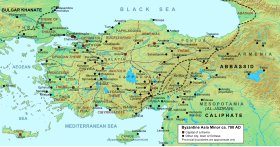
Back الحملة العباسية على آسيا الصغرى (806) Arabic Εισβολή των Αββασιδών στη Μικρά Ασία (806) Greek Abasida invado de Malgranda Azio (806) Esperanto Invasión abasí de Asia Menor (806) Spanish Invasion abbasside de l'Asie Mineure (806) French Invasi Asia Kecil oleh Abbasiyah (806) ID Invasione abbaside dell'Asia Minore (806) Italian アッバース朝の小アジア侵攻 (806年) Japanese Najazd Abbasydów na Anatolię Polish Invasão abássida da Ásia Menor (806) Portuguese
| Abbasid invasion of Asia Minor (806) | |||||||
|---|---|---|---|---|---|---|---|
| Part of the Arab–Byzantine wars | |||||||
 Map of Byzantine Asia Minor and the frontier region with the Abbasid Caliphate c. 780 | |||||||
| |||||||
| Belligerents | |||||||
| Abbasid Caliphate | Byzantine Empire | ||||||
| Commanders and leaders | |||||||
| Harun al-Rashid | Nikephoros I | ||||||
The 806 invasion of Asia Minor was the largest of a long series of military operations launched by the Abbasid Caliphate against the Byzantine Empire. The expedition took place in southeastern and central Asia Minor, where the two states shared a long land border.
Upon coming to the throne, the Byzantine emperor Nikephoros I (r. 802–811) ceased paying the tribute agreed to by his predecessors with the Caliphate, and launched attacks on the Abbasid frontier regions. The Abbasid caliph, Harun al-Rashid (r. 786–809), who sought to promote himself as a champion of jihad, decided to lead in person a retaliatory attack with the objective of punishing the Byzantines and impressing Abbasid influence upon their emperor.
Harun assembled his army at Raqqa in northern Syria. Medieval historians record numbers to be as high as 135,000 or even 300,000 men. While these are clearly exaggerated according to some modern scholars, it is clear that the Abbasid force assembled for the invasion was far larger than anything seen before. The Abbasid army set out from Raqqa on 11 June 806, crossed the coastal region of Cilicia and the Taurus Mountains, and invaded the Byzantine province of Cappadocia. The Abbasids met no opposition and raided at will, capturing several towns and fortresses. Celebrated in Arab histories was the siege, fall, and sack of the city of Herakleia; its name was later given to a victory monument erected by the Caliph near Raqqa. The Byzantine losses forced Nikephoros to seek peace terms in which he offered a resumption of tribute payments in exchange for the Abbasids' withdrawal. However, this time Harun exacted an additional personal tax levied on the Emperor and his son and heir, Staurakios, as a token of their submission to the Caliph.
Almost immediately following Harun's departure, Nikephoros violated the peace terms by refortifying the sacked frontier forts and stopping tribute payments. However, Harun's preoccupation with a rebellion in Khurasan, and his death three years later, prevented a reprisal on a similar scale to 806. Smaller-scale raids continued on both sides, but the Abbasid civil war, which began after 809, and the Byzantine preoccupation with the Bulgars contributed to a cessation of large-scale Arab–Byzantine conflict for the next two decades.